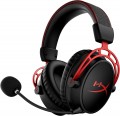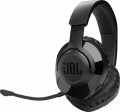Connection type
—
Wired. Headphones connected to the signal source with a cable. Such a connection is highly reliable and noise immunity, gives a minimum of distortion; the headphones themselves turn out to be simple, relatively inexpensive, light, moreover, they do not require their own power supply and have an unlimited operating time. The main disadvantage of this option is the presence of a wire, which limits the range and can create various inconveniences.
—
Wireless. Headphones using a
Bluetooth,
radio, or
infrared connection. The most obvious advantage of such models is the absence of a wire, which makes them very convenient to use; and the range is usually at least a few metres. On the other hand, wireless models are noticeably more expensive than wired counterparts, they have a limited operating time and require periodic recharging, and it is more difficult to achieve high sound quality in such devices (there are special technologies like aptX, but they increase the cost even more). In addition, traditional wireless headphones are also heavier and bulkier than wired ones; these shortcomings are devoid of
true wireless models, but they have their own nuances.
—
Combined. Headphones that allow both of the above connection option
...s. The most popular type of such "ears" are wireless models with a detachable cable(see the relevant paragraph); another option is wired headphones with a standard plug, equipped with an adapter for wireless connection. Anyway, having such a model, the user can choose the connection method at his discretion: for example, you can listen to music from a computer via a wire, and when you leave the house, connect your “ears” to your smartphone via Bluetooth. At the same time, the combined devices are not afraid of a dead battery: you can simply switch the “ears” to the cable and continue to use them. The main disadvantage of this type of headphones is the rather high cost.Cable supply
How to connect the cable to the headphones.
— One-
sided. In such models, the wire is connected to only one earphone. This option is more comfortable and less prone to tangling, but the headphones must have a headband or neck mount so that there is somewhere to hide the wire that goes to the second ear.
—
Bilateral. In such models, a wire is connected to each “ear” separately (the cable for this is usually “forked” closer to the headphones, and sometimes at the plug itself). This is the only option technically available for headphones without a headband or neckband. At the same time, overhead "ears" with a headband can also be made bilateral — in particular, high-end hi-fi and hi-end models, where such a design is provided in order to reduce the influence of wires on each other.
Range
Range of wireless-capable headphones (see "Connection type").
When evaluating the range, it should be taken into account that this parameter is rather conditional and the actual range may differ slightly from the claimed one (usually in a smaller direction). So, when connecting via a radio channel, the range is indicated for perfect conditions — without interference and obstacles in the signal path. For Bluetooth models, the range also depends on the power of the Bluetooth module in the device to which the “ears” are connected. And the effectiveness of the IR channel may be reduced in hot weather or in bright sunlight. So when choosing according to this indicator, it's ok to take a certain margin.
On the other hand, there are two points worth noting. Firstly, in general, the specified range accurately describes the capabilities of the headphones, and it is quite possible to evaluate and compare different models with each other. Secondly, even in the most modest wireless “ears”, the communication range is about
8–10 m,
11–20 m is considered an average, and a fairly large number of devices can operate at distances of
tens and even hundreds of metres. So paying attention to the range makes sense mainly in cases where you plan to move away from the signal source at a considerable distance — from 5 m or more — or listen to sound through walls.
Detachable cable
Headphones in which the cable is mounted on a detachable mount and can be detached. A standard 3.5 mm mini-Jack usually acts as a mount, sometimes a USB connector, and the wire itself may not even be included in the package.
This feature is popular primarily among combined models, see "Type of connection": when working in wireless mode, the cable can be disconnected so that it does not hang out in vain. But for purely wired headphones, the main convenience is that, if desired, the “native” wire can be replaced with another one that differs in length, type (see above), connection connector, etc. If desired, you can even keep several
detachable cables with different characteristics and change them as needed. In addition, if the detachable wire is damaged, you do not need to buy new headphones or go to the workshop — just buy a new cable.
Among the disadvantages of this option, one can note the risk of losing the wire, as well as a slightly increased likelihood of distortion due to the presence of additional connectors.
Impedance
Impedance refers to the headphone's nominal resistance to AC current, such as an audio signal.
Other things being equal, a higher impedance reduces distortion, but requires a more powerful amplifier — otherwise the headphones simply will not be able to produce sufficient volume. Thus, the choice of resistance depends primarily on which signal source you plan to connect the "ears". So, for a portable gadget (smartphone, pocket player), an indicator of
16 ohms or less is considered optimal,
17 – 32 ohms is not bad. Higher values —
33 – 64 ohms and
65 – 96 ohms — will require quite powerful amplifiers, like those used in computers and televisions. And models with a resistance of
96 – 250 ohms and
above are designed mainly for Hi-End audio equipment and professional use; for such cases, detailed recommendations for selection can be found in special sources.
Frequency range
The range of sound frequencies that headphones can reproduce.
The
wider this range, the more fully the headphones reproduce the spectrum of sound frequencies, the lower the likelihood that too low or too high frequencies will be inaccessible. However, there are some nuances to consider here. First of all, let us remind you that the perceptual range of the human ear is on average from 16 Hz to 22 kHz, and for the complete picture it is enough for headphones to cover this range. However, modern models can significantly exceed these boundaries: in many devices the lower threshold
does not exceed 15 Hz, or even
10 Hz, and the upper limit can reach
25 kHz,
30 kHz and even
more. Such wide ranges in themselves do not provide practical advantages, but they usually indicate a high class of headphones, and are sometimes given only for advertising purposes.
The second important point is that a wide frequency range in itself is not a guarantee of good sound: sound quality also depends on a number of parameters, primarily the amplitude-frequency response of the headphones.
Sensitivity
Rated headphone sensitivity. Technically, this is the volume at which they sound when a certain standard signal from the amplifier is connected to them. Thus, sensitivity is one of the parameters that determine the overall volume of the headphones: the higher it is, the louder the sound will be with the same input signal level and other things being equal. However, we must not forget that the volume level also depends on the resistance (impedance, see above); moreover, it is worth choosing “ears” for a specific device first by impedance, and only then by sensitivity. In this case, one parameter can be compensated for by another: for example, a model with high resistance and high sensitivity can work even on a relatively weak amplifier.
As for specific figures, headphones with indicators of 100 dB or less are designed mainly for use in a quiet environment (in some similar models, the sensitivity
does not exceed 90 dB). For use on the street, in transport and other similar conditions, it is desirable to have more sensitive headphones — about
101 – 105 dB, or even
110 dB. And in some models, this figure can reach
116 – 120 dB. and even
more.
It is also worth noting that this parameter is relevant only for a wired connection according to the analogue standard — for example, via a 3.5 mm mini-
...jack. When using digital interfaces like USB and wireless channels like Bluetooth, the sound is processed in the built-in headphone converter, and if you plan to mainly use this kind of application, you can not pay much attention to sensitivity.Speaker size
The diameter of the speaker installed in the headphones; models with multiple drivers (see "Number of drivers"), usually, the size of the largest speaker is taken into account, other dimensions can be specified in the notes.
In general, this parameter is relevant primarily for over-ear headphones (see "Design"). In them, emitters can have different sizes; the larger it is, the more saturated the sound is and the better the speaker reproduces the bass, however, large emitters have a corresponding effect on the dimensions, weight and price of the headphones. But in-ear "ears" and earbuds, by definition, have very small speakers, and rich bass in them is achieved due to other design features.
Harmonic distortion coefficient
The coefficient of harmonic distortion produced by this model of headphones.
This parameter determines the amount of non-linear distortion introduced by the headphones into the reproduced sound. The lower it is, the less such distortions, the cleaner and closer to the original sound is. So, an indicator of 1% or more can be considered tolerable at best, from 0.5% to 1% — good, less than 0.5% — excellent (such indicators are acceptable even for monitor headphones), and less than 0.1% — almost perfect.
Note that a low harmonic coefficient in itself does not guarantee high-quality sound — a lot depends on other features of the headphones, primarily the frequency response.

